M.R. James is considered the greatest writer of ghost stories ever to come out of England.
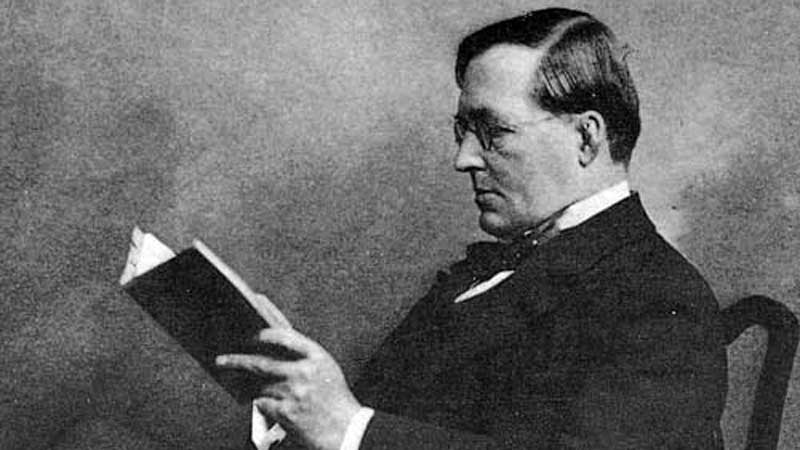
Over 70 years after his death his collected editions remain in print, and no festive season would be complete without one of his tales being adapted for the ever popular “ghost story for Christmas” TV series.
But did James find inspiration for the horrors which haunt his “ Christmas entertainments” in his own uncanny experiences.
EDDIE BRAZIL explores the idea that some of his classics of supernatural fiction could well have been based on real paranormal incidents
Who was M.R. James?
Montague Rhodes James was born in 1863 at Goodnestone Parsonage in Kent, and later raised at Great Livermere in Suffolk where his father was Rector.
He attended Eton College, where he would later become Provost, and Cambridge University where he was vice chancellor during the First World War.
He was an antiquarian, medievalist, bibliographer and an expert on the early history of the bible.
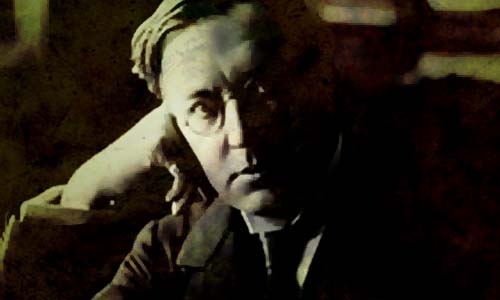
Yet today he is best remembered for his ghost stories, which is a little ironic for he wrote them mainly for his own amusement or to entertain friends at Christmas.
All are classics of the genre and 100 years on still have the power to chill the reader.
But were any of his stories based on fact?
When asked, James maintained that places are far more prolific in suggestion.
He liked to place his characters in as realistic a setting as possible, and would often use existent or amalgamated towns, churches and landscapes together with real publications, guides and county histories, which imbued his stories with a kind of ambiguous authenticity that he was often asked if the tales were in fact true.
His vast knowledge of ancient manuscripts and medieval history undoubtedly provided him with potent material and background for the many horrors and evil wraiths which are let loose on unsuspecting treasure hunters, stuffy Oxbridge professors, and those curious, and foolish enough to cross the supernatural Rubicon in their pursuit of ancient artefacts.
Vengeful ghosts are pure, unearthly entities
His ghosts are not the pleasant kind; they are out for retaliation.
Unlike Dickens benign spectres from A Christmas Carol, or the prophetic wraith in The Signal Man, James spooks are pure, unearthly, entities. Part ghost, part something from a prime evil past.
They are unforgiving, malevolent, thin, white-sheeted horrors with teeth, talons and hair. Their sole purpose is to pursue, frighten and ultimately destroy those who have crossed the line.
If places were prolific in suggestion to James then the brooding, eerie landscape of East Anglia is the one location he returned to often.
The remote coastal region of Eastern England furnished settings for two of James’s most popular tales, “Oh Whistle and I’ll Come to You my Lad” and “A Warning to the Curious”.
Any reader familiar with this part of England will agree it is indeed a bleak and lonely spot. In the dark winter months, when visitors are rare and the only sounds are the moaning wind, and distant, murmuring sea, the descending November dusk can conjure up any number of imaginary phantoms.
The ingredients of “Oh Whistle and I’ll Come to You my Lad” and “A Warning to the Curious” are typical James.
Solitary academics, or loners on holiday by the out of season seaside who, either by fate or design, stumble across some form of ancient relic to which are attached unknown supernatural powers.
To remove, steal or handle the artefact is to invite trouble of the most terrifying kind. Many of the hapless victims survive the ordeal with just the terror of an unpleasant fright. Yet others are pursued un to death. James uses this plot device time and time again.
His ghosts do not act in a way one would expect the typical spectre of the Victorian era, real or fictional, to behave. For here there are no white ladies, or phantom monks, no spectral coaches, no Women in Black.
If James’ ghosts are encountered they will not be denied. He maintained that a ghost, at least the fictional kind should be nasty, odious and frightening. They offer only malevolence and terror, the glare of an evil face, of pursuing forms in the darkness, and a final, long drawn distant scream.
Yet if James had prescribed rules for the fictional ghost story, what were his views on the reality of the paranormal? He said he was prepared to accept the evidence if it satisfied him, and it’s possible that a curious incident he experienced as a child at Livermere Rectory was indeed paranormal.
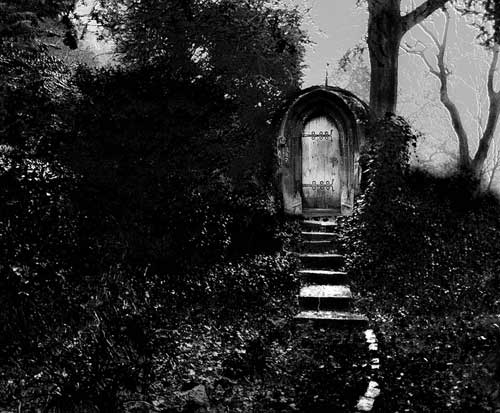
“A Vignette” was written by James in 1935 but not published until after his death in 1936.
It evokes his childhood memories of the family home at Great Livermere, and the first person narrative lends the tale an autobiographical flavour.
The story concerns a strip of land James knew as the plantation, and a gate which separated it from the rectory garden. It was a close gate of split oak with a square hole cut in to it.
When you entered it from one side you put your hand through the hole and lifted the hook which gave entry in to the plantation and then on to a second iron gate which led in to the park. Dotted with dark shrubberies and trees, the plantation becomes a place of foreboding for the young narrator.
Returning home late one afternoon from school he enters and his childhood imagination is filled with all manner of dark fancies. Could there be a hooded figure hiding therein, and making a screen out of a tree trunk and keeping it between you and him as he moves around it and you walk on? He passes quickly through the plantation and closes the gate securely behind him.
Later, in the small hours, he experiences a nightmare. At the full of the moon, He watches from the windows of the rectory and fancies he can see curious movement within the garden. Something was coming towards the house. Still standing at the window he hears footsteps on the stairs and a hand on the door. Salvation comes on waking, and he ponders what the next development might have been. The recurring dream gives him an acute distaste for being alone in that part of the garden, and he observes how villagers passing through the park close to the gate which opened in the plantation did so with some trepidation, and he wonders if there is some unpleasant story connected with area.
Sometime later, alone in the house, he looks down, with apprehension to the plantation gate. It is quite rightly shut. Yet he has the distinct impression that through the square hole in the oak gate he could see something in white. He is determined to know what it is , and makes his way down to the garden. On approaching the gate, to his horror, he views a face looking back at him through the hole. It is malevolent and pink with large open eyes above which hung down the border of a white linen drapery. He at once flees, and on reaching a safe distance looks back. There was no white thing framed in the hole in the gate, but there was a draped figure shambling away among the trees.
As was usual in James’ stories any explanation of the phenomena is not forthcoming. He was of the opinion that to explain the horrors which are let loose on the unsuspecting transgressors of the supernatural Rubicon would be to diminish their power. Reason and logic are the enemies of fear.
However, in the last paragraph of “A Vignette”, James leaves us with some kind of question regarding what he has experienced. He asks, “Are there here and there certain places which some curious creatures still frequent, whom on a time anybody could see and speak to as they went about their daily business, whereas now only at rare intervals does one cross their paths and become aware of them?”
Undoubtedly, James is asking do ghosts exist and do they have the power to harm us?
There is no doubt in my mind that “A Vignette” was furnished by some kind of supernatural occurrence James experienced.
Perhaps he embellished it with his own penchant for ghosts which are thin, pink, hot, malevolent and draped in the tatters of a funeral shroud, and which are always viewed just momentarily out of the corner of the eye and then lost within the shadows.
Did he look down one moonlit night from a window of the rectory on to the darkened garden and, by the gate, view something in white staring back at him. A figure which was there for a moment, and then gone?
Despite its curious content, “A Vignette” is not considered one of James best tales.
Nonetheless, in 1995, during the making of the television documentary,” A Pleasant Terror, The life and Ghosts of M,R. James”, presenter and James devotee, Bill Wallis, visited Livermere to see if he could shine any light in to the origins of the tale. There he met long standing Livermere resident, Beryl Dyson.
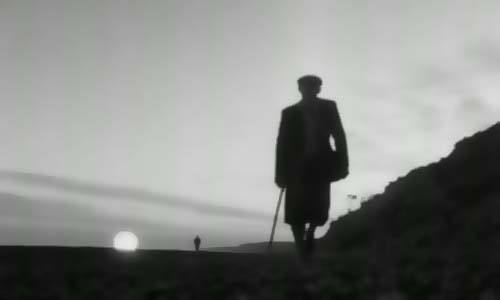
She had known James stories for many years but had never before come across “ A Vignette”. She was further intrigued when Wallis informed her that the story was set in the garden of the rectory, and featured a wooden gate with a square hole, through which James describes the face staring back at Him.
When Beryl Dyson showed Wallis the area it was he who was equally fascinated when told that such a gate had at one time been set in to that part of the rectory garden wall.
He was further astonished to learn that the villagers had always considered the area between the park and the boundary wall to be haunted.
Apparitions had been observed and animals stay away from the place.
Dyson went on to inform him that villagers walking their dogs are mystified when the pet stops dead in its tracks and looks towards the site of the garden gate and stares intently at something which is not visible.
She could be depicting how James himself describes the scene in “A Vignette”, “and he observes how villagers passing through the park close to the gate which opened in the plantation did so with some trepidation, and he wonders if there is some unpleasant story connected with area”.
Yet it seems that it was not only “A Vignette” which was suggested by a genuine paranormal experience. There is one other tale which I believe was inspired either by James’s own personal experience or at least suggested by a paranormal incident he was made aware of.
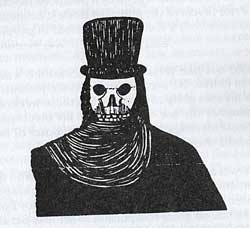
Count Magnus was written in 1900. It concerns a Mr Wraxell who is researching in to the life of a 16th century Swedish nobleman, Count Magnus De la Gardie, Lord of Raback. As in most of James stories Wraxell crosses some kind of supernatural boundary in probing the background of the Count, and now he must pay a price. He flees back to England pursued by two shadowy figures. On reaching a crossroads near the village of Belchamp St Paul in Essex he is confronted by his pursuers.
“At the corner two figures were standing motionless. Both were in dark cloaks. The taller one wore a hat, the shorter a hood.”
Now this description bears a uncanny similarity to an encounter experienced by ley line expert Stephen Jenkins and his wife Thelma, on the 28th of August near Belchanp St Paul, which, incidentally is only two miles from the site of the most haunted house in England, Borley Rectory.
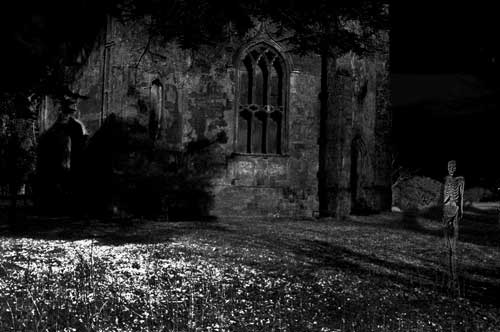
They were driving along a road near to Belchamp St Paul when in front appeared four men, in black, carrying a coffin. “I thought them hooded and cloaked”. Says Jenkins. However his wife describes one of the Men as wearing a soft tall hat. Both at once made notes of the encounter. The impression it made on them was of absolute physical presence, of complete material reality.
As they watched the men crossed the road and vanished. The next day they returned to the exact same spot at the same time and took a picture. The print revealed, in the hedge near the gap where the four men had vanished, a short hooded figure apparently with its face lowered and skull like dome to the head. Is this apparition the model for James shadowy pursuers?
Parapsychologists would argue that Jenkins and his wife must have, at some time read Count Magnus. Although not thinking about the story at the time of their experience it was, nonetheless buried deep within their subconscious. Driving along the road to the Belchamp area triggered some recall of Mr Wraxell’s encounter resulting in a momentary hallucination. Yet Stephen Jenkins and his wife are adamant that what they saw was as real as any flesh and blood human being. Is it to fanciful to ask did James chose Belchamp St Paul because he was aware that the area was haunted by the men in black, or did he himself, at one time, encounter them?
The horrors and wraiths which haunt the work of M.R. James could be seen as the precursors of the modern day ghost.
Today the majority of paranormal experiences are far removed from the benevolent, candlelit spectres of the Edwardian era.
It is the Poltergeist which has now become the most frequently reported case of haunting.
Disturbing accounts of illogical, malevolent and at times, seemingly evil psychic phenomena seem to be the norm in this all to modern catalogue of paranormal activity.
Parapsychologists seem happy enough to explain away the irrational behaviour of the poltergeist as the unconscious frustrated anger of disturbed teenagers.
While other psychical researchers would, controversially view the phenomena as the actions of spirit entities which seem to possess some form of rudimentary intelligence, and whose purpose is to harm, disturb or frighten.
This latter viewpoint, laughable to the sceptic and beyond the scientific pale for many may be, for the present the only explanation for phenomena which is impossible to examine scientifically or explain rationally, but which nonetheless, has been witnessed by many who are convinced that what they experienced was indeed something beyond what we would understand as a ghost, or for that matter the paranormal.
It is also phenomena, as these two examples will show, which seems to have stepped straight out of the pages of an M.R. James story.
Ghostly laughter from insane woman
In 1988, Leicestershire-based paranormal researcher, Rita Goold decided to investigate the claims that the 13th century parish church of St Andrew, Stoke Dry, in the county of Rutland, was haunted by a woman murdered in the 17th century.
In a room, above the church porch a former vicar is believed to have imprisoned a local woman parishioner during the witch purges of the 1640s.
Her screams and cries went unheard for several days and she was brutally starved to death.
It is the ghostly laughter of this unfortunate wretch, driven to insanity, which is said to echo through out the church.
Goold was accompanied by a friend, John Barden, who had never before took part in an all night vigil.
They visited Stoke Dry with the intention of carrying out a preliminary inspection in preparation for their investigation of the church.
On arrival Goold and Barden found that another party, a husband and wife together with grown-up children were already inside looking around the building. Not wanting to draw attention to what they were doing, John Barden suggested that they wait in their car.
Shortly afterwards, pandemonium broke out as they saw a young woman rush from the church across the churchyard and frantically knock for help on the door of a nearby house.
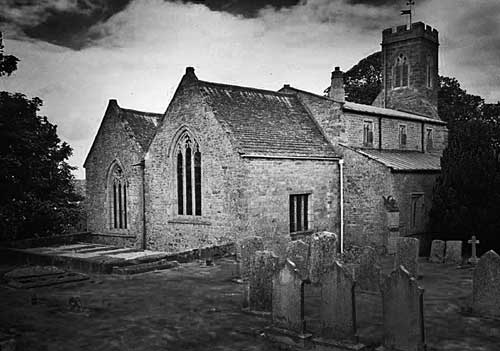
At once all was urgency as people, including the churchwarden rushed to the church, and after a short time an ambulance crew arrived and went inside the building.
Wondering what on earth was happening, Rita Goold and John Barden went over to the church but were prevented from going inside by the St Andrew’s churchwarden who revealed that the husband of the party had collapsed and died while standing next to the church altar.
As they stood talking in hushed tones all three heard the sudden but clear sound of a harsh female voice laugh out and echo round the inside of the building.
The sound lasted several seconds, the churchwarden’s face went pale and he visibly sagged in the doorway.
The two investigators looked at each other, each thinking that the wife had become hysterical but it was not the case as the churchwarden later admitted.
After the ambulance crew had taken the man’s body out of the church and the building became empty he spoke with them again, asking for confirmation of what they thought they had heard.
He then confessed that the same sound of laughter had been heard inside St Andrew’s on a number of occasions, most often when a funeral service was taking place.
‘She is waiting for her love’
Rita Goold and John Barden entered the church and found that the spot where the father had died was the grave of an eleven-year-old girl whose epitaph strangely states “she is waiting for her love”.
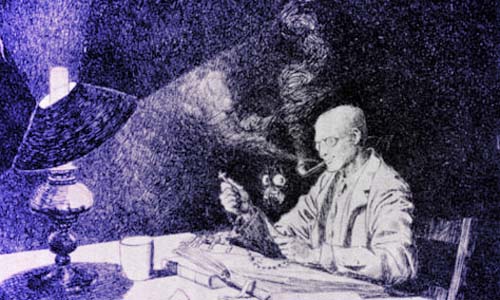
Was she the person who heartlessly laughed out, seemingly from beyond the grave; or could it have been the tortured soul of the starving screaming witch?
Whatever the origin of the ghostly laughter the experience was to prove to unnerving for John Barden and he withdrew from the vigil in the church.
This account of diabolical laughter has a curious echo of life, or in this case afterlife, imitating art.
For in one of M.R. James earliest stories, “Canon Alberic’s Scrapbook”, a tale of a cursed book and a haunted church, a Sacristan/churchwarden informs his daughter,” He (the horrible thing) was laughing in the church again”.
Bedroom attack in the night
In 1971, Joy Makenna and her husband were living in large Cotswold stone house in the village of Broadway in Gloucestershire.
Her husband’s job required him to make business trips which necessitated starting early.
So as to not disturb his wife at such an hour he took to sleeping in the guest room.
On one such occasion in November 1971, Joy had gone to bed around 11 pm and fell asleep almost immediately.
She awoke sometime later, and became suddenly aware that there was a presence in the room moving along the side of the bed.
At first she thought it might be her husband searching for something in the room and trying not to disturb her.
But the sound of his gentle snoring from the next room told her otherwise.
Instinctively she pulled the covers over her head.
Yet Instantly the form creeping about the room leapt upon her, and writhing and mauling, began to punch her like a demented beast.
She felt paralysed, and although she could her move her mouth she could not utter a sound.
Her terror increased, for as she lay in darkness under the covers, she could clearly see two terrible eyes, long, amber and burning with rage staring at her.
Fearing that she was about to die she prayed vehemently, begging God to drive away the intensity of evil in the room.
Immediately she was conscious of the immense weight slithering in a strange obscene fashion over the side of the bed.
Moments later her husband, alarmed by her shouts, rushed in, and whatever it was that had slithered off the bed and on to the floor had gone.
Joy MaKenna and her husband looked coldly at events and tried to find some rational explanation for the terrifying episode, but found nothing, until Joy recalled a strange incident in the bedroom a few days earlier.
She had gone in to the room and noticed a form or hump under the counterpane.
She initially thought it was one of her cats, but they were all downstairs.
As she watched the shape slid in a single, sinuous fish-like movement over the side of the bed and vanished.
The phenomena did not happen again, and Joy and her husband remain in complete bewilderment as to the nature and cause of the incident
Once again inexplicable phenomena of this kind reminds us of another of James’ stories.
“Rats” written at the turn of the century tells of a traveller putting up at an inn by the east coast, and in a bedroom is confronted by the ghost of a long dead landlord… ”Under the counterpane someone lay, and not only lay but stirred, and heaved, and shivered.”
M.R. James stories do not conformed
Disturbing and astonishing as these accounts of paranormal phenomena are we would have to concede that they do not conform to the definition of what most of us would regard as a ghost.
Certainly not the kind which many would assign to the stone tape theory, or those historical apparitions which act out the same scene year in and out.
They appear to be those things which Shakespeare describes as being “in heaven and earth, but not dreamt of in our philosophy”.
Nonetheless it is fascinating to wonder if James was writing today what might he have conjured from these “modern hauntings”.
One problem would undoubtedly be , “letting the ominous thing put out its head in to this calm environment”.
A difficult thing to achieve in the madness of the 21st century.
The anxieties, fears and frustrations which are part and parcel of the modern would seem to concern us more than those things which go bump in the night.
And yet in saying that who would deny that many of us, if faced with spending a night alone in an alleged haunted house, would still tremble at the thought of what piece of nastiness might be waiting for us at the end of the dark corridor.
Montague Rhodes James stories are a continual delight, and for those who’s interest is accounts of ghosts, be they factual or fiction, there can be a no more enjoyable pleasure than to sit by a flickering fire in the small hours with the collected edition in hand.
James once said that he was prepared to accept the reality of the paranormal if the evidence satisfied him.
Yet in his twilight years there was a marked change in his opinion.
Shortly before his death Irish diplomat and writer, Sir Shane Leslie asked him what he really thought on the subject since he had written better ghost stories than any Man living.
He answered: “Depend upon it some of these things are so, but we don’t know the rules.”
EDDIE BRAZIL was born in Dublin in 1956. He is a writer, photographer and paranormal investigator. He is co- author, with Paul Adams and Peter Underwood, of The Borley Rectory Companion and Shadows in the Nave: A Guide to the Haunted Churches of England. In 2012, with Paul Adams, he co wrote Extreme Hauntings: Britain’s Most Terrifying Ghosts, and in 2013 he published the first ghostly guide to his hometown Haunted High Wycombe. He has recently completed a bloody history of Buckinghamshire, which will be published in November. He is also a guitarist , and in 1983 wrote the theme music to the British comedy movie,”Expresso Splasho” which featured Gary Oldman and Daniel Peacock. Eddie lives with his wife and Daughter in Hazlemere, Buckinghamshire. Find out more at his website here.







